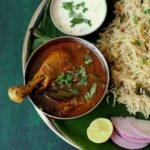Breakfast is often considered the most important meal of the day, and in Indian cuisine, it’s a delightful affair with a variety of flavors, textures, and nutritional benefits. Indian breakfast recipes are not just delicious but also packed with nutrients that provide energy and keep you satiated.

Let’s explore some healthy Indian breakfast options that are both easy to prepare and incredibly satisfying.
1. Poha (Flattened Rice)
Ingredients:
- 1 cup poha (flattened rice)
- 1 medium onion, finely chopped
- 1 green chili, finely chopped
- 1/2 tsp mustard seeds
- 1/2 tsp turmeric powder
- Salt to taste
- 1 tablespoon oil
- Fresh coriander leaves, chopped
- Lemon wedge
- Peanuts (optional)
Instructions:
- Rinse the poha in water until it softens, then drain and set aside.
- Heat oil in a pan, add mustard seeds, and let them splutter.
- Add chopped onions and green chilies, sauté until onions turn translucent.
- Add turmeric powder and salt, mix well.
- Stir in the softened poha, mix thoroughly, and cook for a couple of minutes.
- Garnish with chopped coriander leaves and a squeeze of lemon.
- Serve hot, optionally garnished with peanuts for added crunch.
2. Moong Dal Cheela (Lentil Pancakes)
Ingredients:
- 1 cup yellow moong dal (split mung beans), soaked overnight
- 1 green chili
- 1-inch ginger piece
- Salt to taste
- 1/4 tsp asafoetida (hing)
- 1/2 tsp cumin seeds
- Fresh coriander leaves, chopped
- Oil for cooking
Instructions:
- Grind soaked moong dal with green chili and ginger into a smooth batter.
- Add salt, asafoetida, cumin seeds, and chopped coriander to the batter.
- Heat a non-stick pan and pour a ladleful of batter, spreading it like a pancake.
- Drizzle a little oil around the edges and cook until golden brown on both sides.
- Serve hot with green chutney or yogurt.
3. Ragi Dosa (Finger Millet Crepe)
Ingredients:
- 1 cup ragi flour (finger millet flour)
- 1/2 cup rice flour
- 1/4 cup yogurt
- Water as needed
- Salt to taste
- 1/2 tsp cumin seeds
- Oil for cooking
Instructions:
- Mix ragi flour, rice flour, yogurt, and salt in a bowl. Add water gradually to make a thin batter.
- Let the batter rest for 15-20 minutes.
- Heat a non-stick pan, pour a ladleful of batter, and spread it in a circular motion to form a thin dosa.
- Drizzle a little oil around the edges and cook until crispy.
- Serve hot with coconut chutney or sambar.
4. Vegetable Upma
Ingredients:
- 1 cup semolina (rava/suji)
- 1 medium onion, finely chopped
- 1 carrot, finely chopped
- 1/2 cup green peas
- 1/2 tsp mustard seeds
- 1/2 tsp cumin seeds
- 1-2 green chilies, finely chopped
- 8-10 curry leaves
- 1 tablespoon oil
- Salt to taste
- Fresh coriander leaves, chopped
- Lemon wedge
Instructions:
- Dry roast semolina in a pan until it turns light golden and aromatic. Set aside.
- Heat oil in a pan, add mustard seeds, cumin seeds, green chilies, and curry leaves.
- Add chopped onions, sauté until translucent, then add chopped carrots and peas.
- Add 2 cups of water, salt, and bring it to a boil.
- Gradually add roasted semolina, stirring continuously to avoid lumps.
- Cook on low heat until the water is absorbed and the semolina is cooked.
- Garnish with fresh coriander leaves and a squeeze of lemon.
- Serve hot.
5. Idli with Sambar
Ingredients:
- For Idli:
- 2 cups idli rice
- 1 cup urad dal (split black gram)
- 1/2 tsp fenugreek seeds
- Salt to taste
- For Sambar:
- 1 cup toor dal (split pigeon peas)
- 1 medium onion, chopped
- 1 tomato, chopped
- 1 carrot, chopped
- 1 drumstick, chopped
- 1/2 tsp turmeric powder
- Salt to taste
- 1 tablespoon sambar powder
- Fresh coriander leaves
- Tamarind pulp
- For tempering: mustard seeds, cumin seeds, curry leaves, dried red chilies, asafoetida (hing)
Instructions:
Idli:
- Soak rice and fenugreek seeds together and urad dal separately for at least 4-6 hours.
- Grind the soaked urad dal to a smooth batter and the rice-fenugreek mixture to a slightly coarse batter.
- Mix both batters, add salt, and let it ferment overnight.
- Pour the fermented batter into idli molds and steam for 10-12 minutes.
- Serve hot with sambar and coconut chutney.
Sambar:
- Cook toor dal with turmeric powder until soft, then mash and set aside.
- In a pan, heat oil and add mustard seeds, cumin seeds, curry leaves, and dried red chilies.
- Add chopped onions, sauté until golden brown, then add tomatoes and other vegetables.
- Add sambar powder, salt, and tamarind pulp. Cook until vegetables are tender.
- Add mashed dal, mix well, and simmer for a few minutes.
- Garnish with fresh coriander leaves and serve hot with idli.
Conclusion
These healthy Indian breakfast recipes are not just nutritious but also easy to prepare and incredibly tasty. Incorporate these into your morning routine to enjoy a wholesome and balanced start to your day. Happy cooking!
Top 20 FAQs about Healthy Indian Breakfast Recipes
1. What are some quick and healthy Indian breakfast options?
Answer: Some quick and healthy Indian breakfast options include poha, upma, moong dal cheela, idli, and ragi dosa. These dishes are not only nutritious but also easy to prepare.
2. Are Indian breakfasts typically vegetarian?
Answer: Yes, many traditional Indian breakfasts are vegetarian. Common ingredients include grains, lentils, vegetables, and dairy products like yogurt and paneer.
3. Can I make Indian breakfast recipes gluten-free?
Answer: Yes, many Indian breakfast recipes can be made gluten-free. For instance, poha, moong dal cheela, and idli are naturally gluten-free. For others, you can use gluten-free grains and flours like ragi (finger millet) and besan (gram flour).
4. What are the health benefits of eating a traditional Indian breakfast?
Answer: Traditional Indian breakfasts are rich in complex carbohydrates, proteins, fiber, vitamins, and minerals. They provide sustained energy, support digestive health, and can help maintain a balanced diet.
5. How can I make my Indian breakfast more protein-rich?
Answer: Incorporate ingredients like lentils (moong dal, toor dal), chickpea flour (besan), paneer (Indian cottage cheese), and dairy products (milk, yogurt). Adding nuts and seeds can also boost protein content.
6. What is the best way to store leftovers from Indian breakfast dishes?
Answer: Store leftovers in airtight containers in the refrigerator. Most dishes like poha, upma, and cheela can be reheated in a microwave or on the stove. Idlis can be steamed again to regain their softness.
7. Can I prepare Indian breakfast recipes the night before?
Answer: Yes, you can prep ingredients the night before to save time. For instance, soaking lentils for cheela, chopping vegetables for upma, or fermenting batter for idli can be done ahead.
8. Are there any healthy Indian breakfast options for diabetics?
Answer: Yes, options like ragi dosa, vegetable upma, and moong dal cheela have a low glycemic index and are suitable for diabetics. It’s important to include plenty of vegetables and minimize the use of refined grains and sugars.
9. What are some traditional South Indian breakfast recipes?
Answer: Traditional South Indian breakfast recipes include idli, dosa, uttapam, pongal, and vada. These dishes often use rice and lentils, and are served with sambar and chutneys.
10. Can I make vegan Indian breakfast dishes?
Answer: Yes, many Indian breakfast dishes are naturally vegan or can be easily adapted. Use plant-based milk and yogurt, and avoid ghee or replace it with vegetable oil.
11. What are some healthy additions to Indian breakfast dishes?
Answer: Adding fresh vegetables, leafy greens, herbs, and spices not only enhances the nutritional value but also the flavor. Ingredients like flaxseeds, chia seeds, and nuts can also be incorporated.
12. How can I reduce the oil content in Indian breakfast recipes?
Answer: Use non-stick pans to reduce the amount of oil needed. Opt for steaming or baking instead of frying, and use cooking sprays or minimal oil for sautéing.
13. What are some kid-friendly Indian breakfast options?
Answer: Kid-friendly options include vegetable parathas, idli with chutney, sweet pongal, and stuffed dosas. These can be made appealing with different shapes and mild flavors.
14. Can Indian breakfast recipes be made in advance and frozen?
Answer: Yes, dishes like idli, dosa batter, and upma can be made in advance and frozen. Thaw and reheat them as needed for a quick breakfast option.
15. What are some healthy Indian breakfast drinks?
Answer: Healthy Indian breakfast drinks include masala chai (spiced tea), lassi (yogurt drink), almond milk, and fresh fruit smoothies with Indian spices like cardamom and cinnamon.
16. How can I incorporate more vegetables into my Indian breakfast?
Answer: Add finely chopped or grated vegetables to dishes like upma, poha, and cheela. You can also make vegetable-packed parathas or serve a side of sautéed vegetables with your breakfast.
17. What are some low-calorie Indian breakfast options?
Answer: Low-calorie options include poha, vegetable upma, moong dal cheela, and steamed idli. Avoid using excessive oil and opt for steaming or grilling methods.
18. Are there any traditional Indian breakfast recipes that are also suitable for weight loss?
Answer: Yes, recipes like ragi dosa, vegetable poha, and moong dal cheela are suitable for weight loss due to their high fiber and protein content, which help keep you full longer.
19. What are some breakfast recipes from North India?
Answer: North Indian breakfast recipes include parathas (stuffed flatbreads), chole bhature (spiced chickpeas with fried bread), aloo poori (potato curry with fried bread), and kachori (stuffed pastry).
20. How can I make my Indian breakfast more balanced?
Answer: Ensure a balance of carbohydrates, proteins, and fats in your breakfast. Include whole grains, legumes, lean proteins, and healthy fats. Pair dishes like idli with sambar, or upma with a side of yogurt or a protein-rich chutney.
Related posts:
 ICMR’s Dietary Guidelines Advocate Salt Intake Restriction for Indians
ICMR’s Dietary Guidelines Advocate Salt Intake Restriction for Indians
 A Comprehensive Diet Plan for Effective Weight Loss
A Comprehensive Diet Plan for Effective Weight Loss
 Healthy and Easy-to-Make Lunchbox Recipes for Kids
Healthy and Easy-to-Make Lunchbox Recipes for Kids
 Khana Banane Ki Recipe: Quick and Easy Tips for Delicious Meals
Khana Banane Ki Recipe: Quick and Easy Tips for Delicious Meals
 Superfood Banana: Know THESE 5 Benefits of Kela
Superfood Banana: Know THESE 5 Benefits of Kela
 Why Do Apples Have Stickers? 99% of People Don’t Know the Truth, But It’s Worth Knowing
Why Do Apples Have Stickers? 99% of People Don’t Know the Truth, But It’s Worth Knowing
 Ramadan 2024: 5 Must-Try Traditional Iftar Desserts Across the World
Ramadan 2024: 5 Must-Try Traditional Iftar Desserts Across the World
 5 Rose-Infused Recipes to Elevate Your Ramadan 2024
5 Rose-Infused Recipes to Elevate Your Ramadan 2024
 5 Unexpected Benefits of Consuming One Spoon of Ghee on an Empty Stomach in the Morning
5 Unexpected Benefits of Consuming One Spoon of Ghee on an Empty Stomach in the Morning
